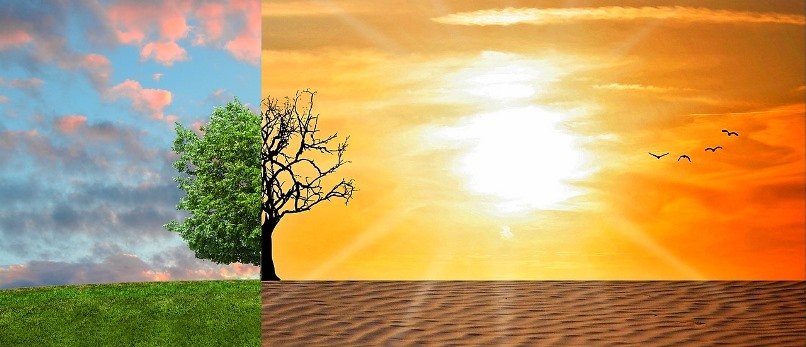Climate Change and The Earth – With the growing Industrialization and Urbanization in the world, we are facing an existential threat in the form of rapid climate change and global warming. According to the scientists across the world, if we continue to exploit the Earth and its available resources at this pace, the consequences will be devastating, having implications on where we live, how we grow food and other services vital to our well-being.

What is climate change?
The climate of the planet has changed continuously in geological time. Today the global average temperature is around 15C, although geological evidence suggests that it has been very high and low in the past.
However, the current period of warming is occurring more rapidly than many previous events. Scientists believe that natural fluctuations in climate are overtaking rapid, human-induced warming, which has serious implications for the stability of the planet’s climate.
Global climate change has already had observable effects on the environment. Our Polar ice caps have been shrinking to an alarming level raising the water content of rivers, oceans and lakes, more intense heat waves are now quite common in several places across the globe. The global mean temperatures will continue to rise for decades to come, largely due to the uncontrolled and unregulated emission of greenhouse gases in the atmosphere produced by human activities. According to the IPCC- Intergovernmental Panel on Climate Change, a temperature rise of 2.5 to 10 degrees Fahrenheit is predicted over the next century.
THE GREENHOUSE GASES
-
Water vapour (H2O)
– This is the most abundant greenhouse gas which is present abundantly in the atmosphere and plays a major role in the concentration of greenhouse gases. As the Earth’s atmosphere increases, the concentration of Water Vapour in the atmosphere increases which in turn also leads to the formation of clouds and precipitation, making it one of the most important feedback mechanisms to the greenhouse effect.
-
Nitrous Oxide (N2O)
– The Nitrous Oxide gas is a powerful GHG which is released in the atmosphere owing to the soil cultivation practices, especially by the use of commercial and organic fertilizers. Several other factors like fossil fuel combustion, nitric acid production, and biomass burning also add to the N2O content in the atmosphere.
-
Carbon Dioxide (CO2)
Carbon dioxide, another important GHG is released through natural processes such as respiration and volcano eruptions and through human activities such as deforestation, land-use changes, and burning fossil fuels.
-
Methane (CH4)
Methane is a type of hydrocarbon gas that is produced both through natural sources and human activities, including the decomposition of wastes in landfills, agriculture, and especially rice cultivation, as well as ruminant digestion and manure management associated with domestic livestock. It is the most active GHG in the atmosphere.
-
Chlorofluorocarbons (CFCs)
Chlorofluorocarbons are a kind of Synthetic compounds that are released into the atmosphere through the industries and are used in a number of applications, majorly in the refrigerators, aerosol cans, sprays, etc. The use of CFC gases is now completely prohibited.
Also Read : Biodiversity Hotspots in the World
The accumulation of this GHG in the atmosphere beyond the permissible level contributes to rising of the mean global temperature leading to the Climate Change scenario which the current world is facing and would also be faced by our future generations if we fail to take adequate and necessary steps to stop the Global Warming. Humans have a major role to play in increasing the release of GHGs in the atmosphere owing to the growing Modernization, Urbanization and Industrialization.
WHAT LEADS TO THE CLIMATE CHANGE
- Urbanisation – Both global warming and urbanisation can enhance warming in cities and their surroundings. Night-time temperatures are more affected by this effect than daytime temperatures due to the Heat Island effect. Increased urbanisation can also intensify extreme rainfall events over the city or downwind of urban areas.
- Land Degradation– A major portion of the Earth’s ice-free land area is subject to human-induced degradation leading to soil erosion from agricultural fields with an estimated level of 10 to 20 times to more than 100 times higher than the soil formation rate Climate change exacerbates land degradation, particularly in low-lying coastal areas, river deltas, drylands and in permafrost areas. People living in already degraded or desertified areas are increasingly negatively affected by climate change.
- Growing Population– The increasing global population which in turn, changes the per capita consumption of food, feed, fibre, timber and energy have caused unprecedented rates of land and freshwater use with agriculture currently accounting for 70% of global fresh-water use. Expansion of areas under agriculture and forestry, including commercial production, and enhanced agriculture and forestry productivity has supported consumption and food availability for a growing population. With the large regional variation, these changes have contributed to increasing net GHG emissions, loss of natural ecosystems (e.g. forests, savannahs, natural grasslands and wetlands) and declining biodiversity.
- Over Exploitation of Land Resources– Land provides the basis for many of the ecosystem functions and services like the production of food, feed, fibre, timber and energy, including cultural and regulating services that are essential for humanity. Burning of fossil fuel like coal and wood contributes to the release of CO2 gas in the atmosphere similarly the cultivation of paddy fields releases the methane gas into the atmosphere.
HOW IS CLIMATE CHANGE AFFECTING THE EARTH
With the Earth-facing the ill effects of climate change in the terms of human health, agriculture and food security, water supply, transportation, energy, ecosystems, and others, these services are more likely to be disruptive in the near future if adequate steps are not taken today for saving the Earth from this menace.
- Climate change is affecting human health and wellbeing via some of the most extreme weather events and wildfires, decreased air quality, and diseases transmitted by insects, food, and water.
- Climate disruptions to agriculture have been increasing and are projected to become more severe. The surface and groundwater supplies in many regions across the globe are already depleted, and water quality is also degraded in many areas due to increasing sediment and contaminant concentrations.
- The events of forest wildfires and longer fire seasons are the results of prolonged exposure of high-temperature periods in an area that is also associated with droughts.
- Sea levels have been rising tremendously owing to the melting of polar ice caps and glaciers due to rising temperatures. In many of the areas, coastal storms are now common that has increased the risk of erosion, storm surge damage, and flooding. Factors such as overfishing and pollution to alter marine-based food production are harming the fishing communities.
FIGHTING CLIMATE CHANGE
Fighting climate change is not the aspect that is meant to be covered only by the government. We, as individuals, also are equally responsible for the current scenario and status of the Earth which makes us equally responsible for taking steps to combat Climate Change. We shall know our duties and deeds that are a must for us to follow in order to help heal the environment and maintain the Earth’s natural cycle. Some small but effective steps that we could take a note of can to be by.
-
Commuting in a More Sustainable way
As we all know, the greater the use of vehicles in our modern-day society, larger would be the emission of GHGs into the atmosphere. Exploring the options of car-pooling, using public transport, walking or cycling to work are some of the suggested measures which can be adapted by us in our lifestyles to reduce vehicular emissions thus lowering the GHG emission in the atmosphere.
-
Sustainable use of Energy
Using energy in an efficient way at home, workplace, industries, factories, etc. is a great way to prevent pollution. When the consumption level of energy is lower, the power plants would be producing less energy which in turn could turn down the production of greenhouse gases from the power plants. Cutting down on energy usage, replacing the bulbs with higher energy efficacy or LED bulbs, turning the lights off and unplugging devices that are not in use are some of the steps that could be taken at an individual level towards contributing their bit for a better climate.
-
Following the 3R formula i.e., Reduce, Reuse and Recycle
Reduction in our consumption and need values contributes towards less manufacturing of products that are causing the larger emission of GHGs in the atmosphere. Limiting our consumption to the necessary values may help. Similarly, following the process of reusing our products also leads to lesser production of products. Reusing cups, plates, water bottles, etc. reduces the pressure on Earth of their disposal. Adopting a cleaner alternative would be to invest in recycling. Recycling is a cost-effective and eco-friendly process that works by eliminating the waste products generated and doesn’t emit greenhouse gasses into the environment.
-
Creating awareness among people
The importance of educating others about climate change is the utmost necessity of today’s era as we only are the sole contributors to the Climate Change menace. Educating others on the dangers of climate change and how to act against it can prove to be effective in the long run.

She is a Conservation Biologist deeply concerned with the protection and sustainability of natural resources and wildlife. She is particularly interested in studying and addressing the loss of Biodiversity and educating the people about the same. She has a Master’s degree in Zoology with Post Graduate Diploma in Environment and Sustainable Development and another in Sustainability Sciences.

Pingback: The Concept of Green Schools - The Mighty Earth
Pingback: What is Global Warming, Causes and Effects - The Mighty Earth
Pingback: Biodiversity Hotspots in the World - The Mighty Earth
This is so great I think others could benefit from learning about it.
The thought of creating awareness among people is appreciable as we all know how much the climate has changed since last few years. Not only to save the climate but to save resources and to survive we have to follow the 3R’s formula. But above all, awareness of how big is the problem, is the major task to be done.
Great work, keep it up…
Great website!!! 👍🏻
Thank You for visiting our website.
We are glad to know that our efforts are being noticed and are acclaimed.
Please do visit our website regularly for new contents on various Environmental issues and concerns.
Once again
Thank You